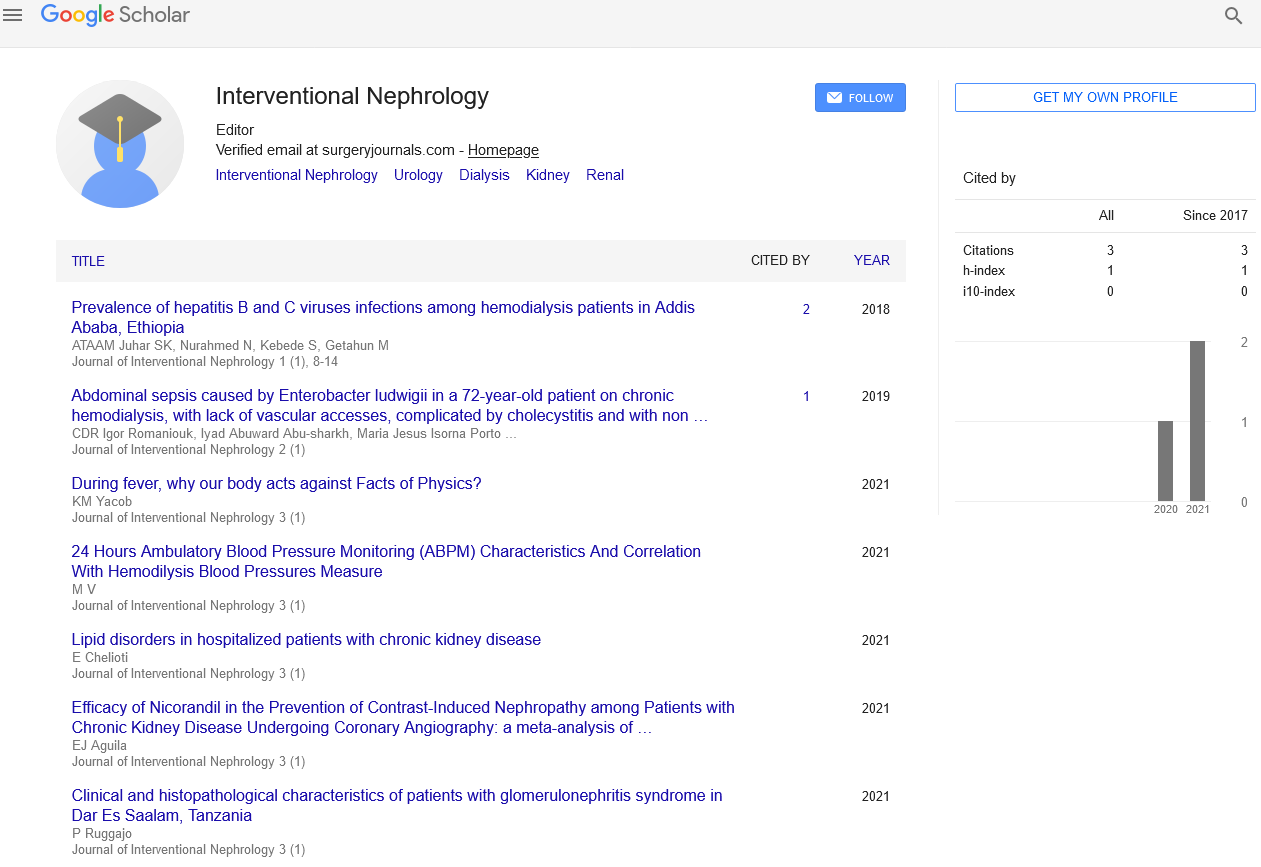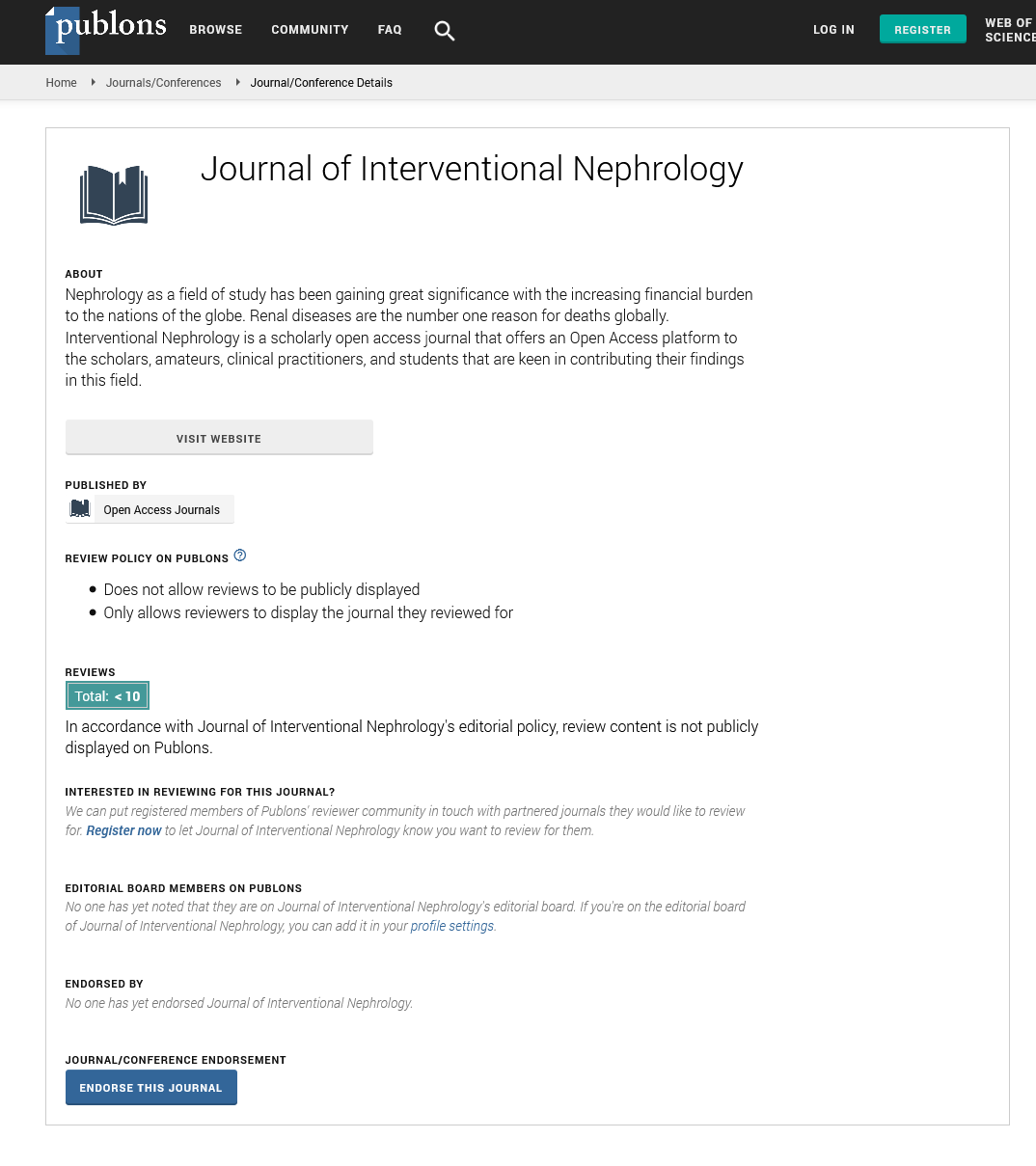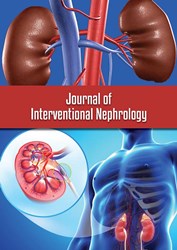Editorial - Journal of Interventional Nephrology (2022) Volume 5, Issue 6
Effect of Renal Illness on the Results of Glen humeral Osteoarthritis Elective Shoulder Replacement Surgery
Mathew Nicolson*
Department of Nephrology, UCL College of Medicine, United Kingdom
Department of Nephrology, UCL College of Medicine, United Kingdom
E-mail: Mathew33@hotmail.com
Received: 01-Dec-2022, Manuscript No. oain-22-83964; Editor assigned: 03-Dec-2022, PreQC No. oain-22- 83964; Reviewed: 17-Dec-2022, QC No. oain-22-83964; Revised: 19-Dec- 2022, Manuscript No. oain-22-83964 (R); Published: 26-Dec-2022; DOI: 10.47532/oain.2022.5(6).75-76
Abstract
Primary glenohumeral osteoarthritis has been linked to renal disease, including chronic renal disease and end-stage renal disease. The effects of renal illness on recovery from shoulder arthroplasty, however, are little understood. Consequently, the goal of this study was to assess how renal illness affected the results of shoulder arthroplasty for glenohumeral osteoarthritis.
Introduction
A total of 29,336 individuals received shoulder arthroplasty for glen humeral osteoarthritis between 2010 and 2014. 27 928 (95.2%) of these 29,336 patients had no renal disease, 1355 (4.6%) had chronic renal disease requiring dialysis, and 53 (0.2%) had endstage renal disease. Patients with end-stage renal disease and predialysis chronic renal disease were more likely to require blood transfusions (odds ratio [OR] = 2.04, P .0001, and 5.37, P =.04, respectively) and experience any postoperative complications during the index hospitalisation (OR = 2.31, P .0001, and 3.94, P =.003, respectively) compared to patients without renal disease. Patients with predialysis-dependent chronic renal disease were more likely to have cardiac (OR = 1.96, P .0001), respiratory (OR = 1.55, P .0001), and acute renal failure (OR) problems [1].
Patients with end-stage renal disease were more likely to experience cardiac (OR = 3.87, P =.003) and acute renal failure (OR = 10.35, P =.002) problems after surgery. Patients with end-stage renal illness had a higher risk of dislocation (OR = 8.70, P =.039), hospital readmission (OR = 8.01, P .0001), and surgical site infection (OR = 19.06, P =.001) after 90 days. Last but not least, patients with predialysis chronic renal disease and patients with end-stage renal disease both had longer hospital stays and cost more money than patients without the condition; predialysis chronic renal disease patients also had a higher risk of being discharged to a skilled nursing facility [2-4].
Methods
Using the Nationwide Readmissions Database, a retrospective analysis was conducted. Patients who underwent shoulder arthroplasty for primary glen humeral osteoarthritis, including total shoulder arthroplasty and reverse total shoulder arthroplasty, were identified using International Classification of Diseases, 9th Revision, codes. No renal disease, predialysis chronic renal illness (encompassing stages 1-5), and end-stage renal disease were the three categories into which these individuals were split. The risk of complications both during and 90 days after the index procedure were the primary outcomes of interest. Index hospitalisation duration of stay, cost, and discharge location were considered secondary outcomes [5].
This retrospective cohort analysis reveals that even people with chronic renal disease on dialysis have worse results following shoulder replacement surgery for glen humeral osteoarthritis than patients without renal disease. These results serve to emphasise the significance of careful preoperative surveillance to avoid problems in a patient population that may be disregarded [6].
Over a 5-year period, the study cohort was found in the Nationwide Readmissions Database (2010-2014). The Agency for Healthcare Research and Quality financed the development and validation of the nationwide representative database known as the Nationwide Readmissions Database. It is based on patient tracking data from 22 state inpatient databases that span numerous hospitals. 49.3% of all hospital admissions in the US and about 51.2% of the US population [7,8].
Conclusion
This retrospective cohort study reveals that postoperative problems following SA are more likely to occur in individuals with various levels of RD, namely predialysis CRD and ESRD. While the effects of renal dysfunction on postoperative outcomes following SA have been discussed in a number of publications, examination of renal function was limited to the presence or absence of illness. Our data imply that people who had both CRD and ESRD prior to dialysis [9,10].
Acknowledgement
None
Conflict of Interest
None
References
- Phramor, Lucy. Validity of claims made in weight management research: a narrative review of dietetic articles. Nutrition Journal. 9, 30 (2010).
- Long Zichong, Huang Lili, Lyu Jiajun et al. Trends of central obesity and associations with nutrients intake and daily behaviors among women of childbearing age in China. BMC Women's Health. 22, 12 (2022).
- Melina Vesanto, Craig Winston, Levin Susan et al. Position of the Academy of Nutrition and Dietetics: Vegetarian Diets. J Acad Nutr Diet.116, 1970-1980 (2016).
- Mueller-Stierlin AS, Cornet Sebastian, Peisser Anna et al. Implications of Dietary Intake and Eating Behaviors for People with Serious Mental Illness: A Qualitative Study. Nutrients. 14, 2616 (2022).
- Johnson VR, Washington TB, Chhabria Shradha et al. Food as Medicine for Obesity Treatment and Management. Clinical Therapeutics. 44, 671-681 (2022).
- Partridge L, Deelen J, Slagboom PE et al. facing up to the global challenges of ageing. Nature. 561, 45-56 (2018).
- Coman V, Vodnar DC. Gut microbiota and old age: Modulating factors and interventions for healthy longevity. Experimental Gerontology. 141, 111095 (2020).
- DeJong EN, Surette MG, Bowdish DM et al. the Gut Microbiota and Unhealthy Aging: Disentangling Cause from Consequence. Cell Host & Microbe. 28, 180-189 (2020).
- Warman DJ, Jia H, Kato H et al. The Potential Roles of Probiotics, Resistant Starch, and Resistant Proteins in Ameliorating Inflammation during Aging (Inflammaging). Nutrients. 14, 747 (2022).
- Fong BY, Chiu WK, Chan WF et al. A Review Study of a Green Diet and Healthy Ageing. Int J Environ Res 18: 8024 (2021).


